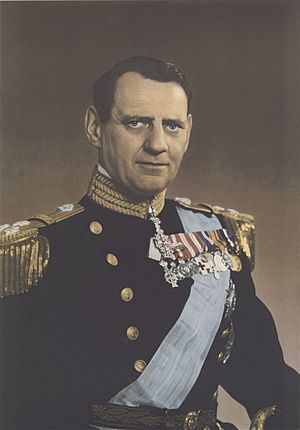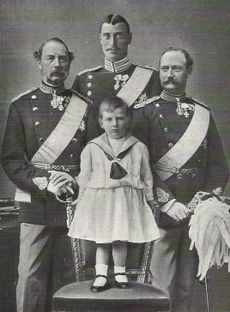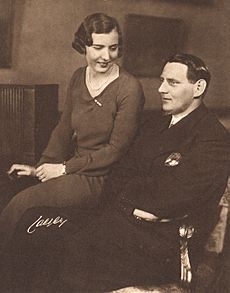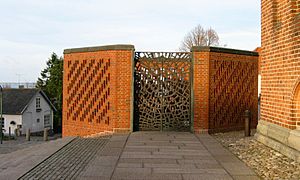Frederick IX of Denmark facts for kids
Quick facts for kids Frederick IX |
|
|---|---|

King Frederick IX c. 1947
|
|
| King of Denmark (more...) | |
| Reign | 20 April 1947 – 14 January 1972 |
| Predecessor | Christian X |
| Successor | Margrethe II |
| Prime Ministers |
Knud Kristensen
Hans Hedtoft Erik Eriksen Hans Christian Hansen Viggo Kampmann Jens Otto Krag Hilmar Baunsgaard |
| Born | 11 March 1899 Sorgenfri Palace, Kongens Lyngby, Denmark |
| Died | 14 January 1972 (aged 72) Municipal Hospital, Copenhagen, Denmark |
| Burial | 24 January 1972 Roskilde Cathedral, Roskilde, Denmark |
| Spouse | |
| Issue |
|
| House | Glücksburg |
| Father | Christian X of Denmark |
| Mother | Alexandrine of Mecklenburg-Schwerin |
| Religion | Lutheranism |
Frederick IX (born 11 March 1899 – died 14 January 1972) was the King of Denmark from 1947 to 1972. He was born into the House of Glücksburg, a royal family. Frederick was the older son of King Christian X and Queen Alexandrine of Denmark.
He became the crown prince when his father became king in 1912. As a young man, Frederick studied at the Royal Danish Naval Academy. In 1935, he married Princess Ingrid of Sweden. They had three daughters: Margrethe, Benedikte, and Anne-Marie.
During World War II, when Nazi Germany occupied Denmark, Frederick acted as a temporary ruler for his father from 1942 to 1943. He became king when his father died in 1947. During Frederick IX's time as king, Danish society changed a lot. The country's social support system, called the welfare state, grew. Also, because the economy was doing very well in the 1960s, more women started working. These changes meant that the monarchy also had to adapt. Frederick IX died in 1972. His oldest daughter, Queen Margrethe II, became the next ruler.
Contents
Early Life and Family

Prince Frederick was born on 11 March 1899. His birthplace was Sorgenfri Palace, his parents' home near Copenhagen, Denmark. This was during the time his great-grandfather, King Christian IX, was ruling.
Frederick's father was Prince Christian of Denmark (who later became King Christian X). His mother was Alexandrine of Mecklenburg-Schwerin.
Frederick was baptized at Sorgenfri Palace on 9 April 1899. He had many godparents, including his great-grandfather King Christian IX, Tsar Nicholas II of Russia, and Prince of Wales (later King Edward VII of the United Kingdom).
Frederick had one younger brother, Knud, who was born a year after him. The family lived in different palaces. Their main home was at Amalienborg Palace in Copenhagen. They also had summer homes at Sorgenfri Palace and Marselisborg Palace.
Becoming Crown Prince
When King Christian IX died in 1906, Frederick's grandfather became King Frederick VIII. This made Frederick's father the crown prince, and Frederick became second in line to the throne.
Just six years later, in 1912, King Frederick VIII died. Frederick's father then became King Christian X, and Frederick became the crown prince.
In 1918, Iceland became an independent country but remained connected to Denmark through the king. So, Frederick also became the crown prince of Iceland. However, Iceland became a republic in 1944, so he never became King of Iceland.
Frederick chose to study at the Royal Danish Naval Academy. This was different from the usual royal tradition of joining the army. He became a rear admiral in the navy and had important leadership roles. He also loved music and was a good piano player and conductor.
Marriage and Children
In 1935, a few days after his 36th birthday, Frederick became engaged to Princess Ingrid of Sweden (1910–2000). She was the daughter of Crown Prince Gustaf Adolf (who later became King Gustaf VI Adolf of Sweden).
They got married in Stockholm Cathedral on 24 May 1935. Their wedding was a very big event in Sweden. Many important guests attended, including the King and Queen of Denmark, and the King and Queen of Belgium.
After their wedding, the couple lived at Frederick VIII's Palace in Copenhagen. They also had a summer home called Gråsten Palace.
Frederick and Ingrid had three daughters:
- Queen Margrethe II, born 16 April 1940. She married Count Henri de Laborde of Monpezat and has two sons.
- Princess Benedikte of Denmark, born 29 April 1944. She married Richard, 6th Prince of Sayn-Wittgenstein-Berleburg and has three children.
- Princess Anne-Marie of Denmark, born 30 August 1946. She married King Constantine II of Greece and has five children.
Frederick's Reign as King
From 1942 to 1943, Frederick was a temporary ruler for his father, King Christian X. His father was unable to rule after falling from his horse.
On 20 April 1947, Christian X died, and Frederick became the new king. The Prime Minister, Knud Kristensen, announced him as king from the balcony of Christiansborg Palace.
Frederick IX's time as king saw many big changes in Denmark. The country moved from being mostly agricultural to a modern society. The welfare state, which provides social support for citizens, grew a lot. Also, because the economy was strong in the 1960s, many women joined the workforce. These changes meant that the role of the monarchy also had to change.
In 1948, one year after Frederick became king, the Faroe Islands gained home rule. This meant they became a self-governing country within the Danish Realm.
Changes to Succession Law
King Frederick IX and Queen Ingrid did not have any sons. According to the old Danish law, Frederick's younger brother, Prince Knud, would have become king.
However, in 1953, a new law about who inherits the throne was passed. This new law allowed daughters to become queen if there were no sons. This change meant that Frederick's oldest daughter, Margrethe, became the next in line to the throne.
Death and Funeral
After giving his New Year's speech in late 1971, King Frederick IX became ill. He had a heart attack and was taken to the hospital on 3 January. His condition worsened, and he died on 14 January 1972, surrounded by his family.
After his death, the King's coffin was taken to his home at Amalienborg Palace. Then, it was moved to the chapel at Christiansborg Palace. Here, the King's body was placed on a special display, a ceremony that has been used for royal burials since 1670. The public could visit to pay their respects for six days.
The funeral took place on 24 January 1972. First, a short ceremony was held in the chapel. Then, members of the Royal Life Guards carried the coffin out. It was placed on a special carriage pulled by 48 sailors. Honor guards from Denmark and other countries escorted the carriage through Copenhagen.
At the Copenhagen Central Station, the coffin was put on a special train to Roskilde. In Roskilde, sailors pulled the coffin through the city to Roskilde Cathedral. The final ceremony was held there. Most past Danish rulers are buried inside the cathedral. However, King Frederick IX wanted to be buried outside.
Succession and Legacy
Frederick IX was succeeded by his oldest daughter, Queen Margrethe II. Queen Ingrid, his wife, lived for 28 years after him. She died in 2000 and was buried next to him outside Roskilde Cathedral.
A statue of King Frederick IX was put up by the Copenhagen harbor on 20 April 1982. He is shown wearing an admiral's uniform. This was to mark 35 years since he became king and 10 years after his death.
Two bridges in Denmark are named after him: the Crown Prince Frederick Bridge and the Frederick IX Bridge. Also, a mountain range in Greenland, called the Crown Prince Frederick Range, was named after him in 1934.
Titles, Styles and Honours
Titles and Styles
- 9 April 1899 – 14 May 1912: His Royal Highness Prince Frederick of Denmark
- 14 May 1912 – 1 December 1918: His Royal Highness The Crown Prince of Denmark
- 1 December 1918 – 17 June 1944: His Royal Highness The Crown Prince of Denmark and Iceland
- 17 June 1944 – 20 April 1947: His Royal Highness The Crown Prince of Denmark
- 20 April 1947 – 14 January 1972: His Majesty The King of Denmark
Honours
- Danish honours
- Knight of the Elephant, 14 May 1912
- Cross of Honour of the Order of the Dannebrog, 11 March 1917
- Grand Commander of the Dannebrog, 3 February 1936
- King Christian IX Centenary Medal
- King Frederik VIII Centenary Medal
- Navy Long Service Award
- Foreign honours
 Iceland: Grand Cross of the Falcon
Iceland: Grand Cross of the Falcon Austria: Grand Star of the Decoration for Services to the Republic of Austria
Austria: Grand Star of the Decoration for Services to the Republic of Austria Belgium: Grand Cordon of the Order of Leopold
Belgium: Grand Cordon of the Order of Leopold Czechoslovakia: Collar of the White Lion, 22 May 1935
Czechoslovakia: Collar of the White Lion, 22 May 1935 Dominican Republic: Grand Cross of the Order of Merit, with Gold Star
Dominican Republic: Grand Cross of the Order of Merit, with Gold Star Ethiopian Imperial Family: Grand Cross of the Seal of Solomon
Ethiopian Imperial Family: Grand Cross of the Seal of Solomon Finland:
Finland:
- Collar of the White Rose, 1926
- Commemoration Medal for the Finnish War of Liberation of 1918
- Gold Commemoration Medal for the Winter War of 1939/40
- Medal for Humane Benevolence
 German Imperial and Royal Family:
German Imperial and Royal Family:
- Knight of the Black Eagle, with Collar
- Grand Cross of the Red Eagle
 Mecklenburg Grand Ducal Family: Grand Cross of the Wendish Crown, with Crown in Ore
Mecklenburg Grand Ducal Family: Grand Cross of the Wendish Crown, with Crown in Ore
 Greek Royal Family:
Greek Royal Family:
- Grand Cross of the Redeemer
- Grand Cross of the Order of George I
- Grand Cross of Saints George and Constantine
- Commemorative Badge of the Centenary of the Royal House of Greece
 France: Grand Cross of the Legion of Honour
France: Grand Cross of the Legion of Honour Iranian Imperial Family:
Iranian Imperial Family:
- Collar of the Order of Pahlavi
 Italian Royal Family: Knight of the Annunciation, 10 March 1917
Italian Royal Family: Knight of the Annunciation, 10 March 1917 Empire of Japan: Collar of the Order of the Chrysanthemum
Empire of Japan: Collar of the Order of the Chrysanthemum Netherlands: Grand Cross of the Netherlands Lion
Netherlands: Grand Cross of the Netherlands Lion Norway: Grand Cross of St. Olav, with Collar, 10 April 1917
Norway: Grand Cross of St. Olav, with Collar, 10 April 1917 Peru: Grand Cross of the Sun of Peru, in Diamonds
Peru: Grand Cross of the Sun of Peru, in Diamonds Russian Imperial Family:
Russian Imperial Family:
- Knight of St. Andrew
- Knight of St. Alexander Nevsky
- Knight of the White Eagle
- Knight of St. Anna, 1st Class
- Knight of St. Stanislaus, 1st Class
 Sweden:
Sweden:
- Knight of the Seraphim, with Collar, 11 March 1917
- King Gustaf V Commemorative Medal
 Thailand:
Thailand:
- Knight of the Order of the Royal House of Chakri, 18 February 1917
- Grand Cordon of the Order of Chula Chom Klao
 United Kingdom:
United Kingdom:
- Stranger Knight of the Garter, 8 May 1951
- Honorary Grand Cross of the Bath
- Honorary Grand Cross of the Royal Victorian Order
- Associate Bailiff Grand Cross of St. John
- King George VI Coronation Medal
Images for kids
See also
 In Spanish: Federico IX de Dinamarca para niños
In Spanish: Federico IX de Dinamarca para niños






